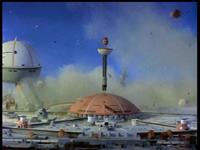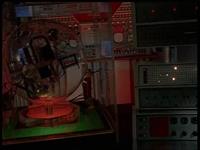Star Maidens

Star Maidens (Die Mädchen aus dem Weltraum in German) was a German/UK science fiction series filmed in summer 1975 and first shown in the UK on ITV in September 1976. For many ITV regions, this was around the same time as Space: 1999 Year Two first appeared. The series had a single series of 13 episodes, each 30 minutes long. About half the main cast were German stars. Many of the behind-the-scenes crew were also German, which caused friction as at least one had to work through an interpreter.
For many viewers, Star Maidens looks like a low budget cousin of Space: 1999. The space science fiction of the basic plot and some episodes are obviously influenced by 1999. Instead of the moon travelling through space, we have an alien planet that arrives in Earth's solar system. The production design has some striking similarities, because the designer was Keith Wilson, fresh from having done the same job on Space: 1999 Year 1 and waiting to continue on Year 2. Also working with him was set dresser Mike Ford.
Two of the lead actors, Judy Geeson and Lisa Harrow, had guest starred in Space: 1999 episodes. A number of supporting cast also appear. The two male leads were Pierre Brice (actually French, but a star in German cinema) and Gareth Thomas, before his role in Blakes 7. Brice was dubbed by Robert Rietty.




Star Maidens also sounds like Space: 1999. The computer bleeps, pulsating alien sounds, spaceship noises and laser beams are exactly the same. The sound editor on both shows was Peter Pennell. The film editor was 1999's Alan Killick.
It was filmed in Bray Studios in 1975, where the special effects for Space: 1999 were filmed (the 1999 crew were on hiatus at the time, between the two series). Extensive use was made of Black Park (alongside Pinewood, and the location for several episodes of Space: 1999). Unlike Space: 1999, Star Maidens was filmed on 16mm film. The difference in quality to Space: 1999 is obvious. The special effects in particular suffer from much more grain and slight shakiness.
The central concept is that the wandering alien planet, Medusa, is a matriarchal society in which women rule and men are meek slaves. "Earth proved to be a great disappointed to us. Contrary to all common sense, it was controlled by men." Two Medusan men escape to Earth in the first episode. About half the episodes follow the Medusan men, and Medusan woman Judy Geeson, on Earth. The other half follow Lisa Harrow and a male colleague who visit Medusa.
Star Maidens veers unevenly between light comedy and action, never finding the right tone. Most of the stories are run-arounds, especially those set on Earth (1970s England wasn't that exciting). In the space episodes, the aspirations of the design and effects are greater than the budget.
It's clearly a reaction to 1970s "women's lib", a hot topic at the time. It inspires some comedy, which now seems terribly dated. Mostly it's played straight, with only one episode really a comedy (The Perfect Couple, set on a 1970s housing estate with the stay-at-home wives). There's no serious explanation or exploration of the theme either. The later episodes become more serious (What Have They Done To The Rain is quite good ecological science fiction; Creatures of the Mind introduces mild horror with lonely robots).


Lisa Harrow had guest starred in Testament of Arkadia


Judy Geeson had guest starred in Another Time, Another Place


Pam Rose was a Medusan guard in several episodes; she had been a stand-in during Year One, and later she was an Alphan in Command Center


Ina Skriver has a small credited guest role in the Star Maidens episode Creatures of the Mind; the next year she had a much more prominent guest role in The AB Chrysalis.


Ann Maj-Britt had appeared as a Main Mission operative Ann in 4 episodes; she appeared as Octavia's assistant in three episodes.
Several stuntmen who worked in Space: 1999 are also visible in Star Maidens, including Paul Weston and Alf Joint. A guest actor who is credited, but barely visible in the episode Hideout, is David Ellison.
The special effects were by Allan Bryce, who did the studio effects for Space: 1999. The lighting cameramen were Alan Hume (Hammer films, various Bond movies and Return of the Jedi), and Paddy Seale (who had been effects cameraman on Gerry Anderson series including Thunderbirds, up to UFO and later on Terrahawks).

This rolling planet shot from the first episode, complete with atmosphere haze, is very similar to Space 1999 effects. The space shots were done with the same double-exposure technique.



More space shots, with airbrushed stars. It looks a little flat, and the lighting and 16mm film cannot really compare to Space 1999.








The city scenes from the titles and first episode. It's ambitious and quite impressive, but it always looks like a model, and the explosions reveal the small size of the models. The city featured as the cover of the 1977 novel and the 1978 children's annual, which is a lot more exposure than it needed.





The hangar and launch silo sequences are excellent; the shots of the main saucer ship (Nemesis) launching and landing are seen multiple times through the series.


Some well-done foreground miniature shots from the second episode.







The main hall of the underground Medusa city. It's a large and impressive set. The towers seen through the top windows are paintings, and the camera angles rarely try to conceal it. The Medusa senate room is also two levels.




The Medusa computers had a similar black and white aesthetic to the Space: 1999 computers, but there was no re-use of props.



Some of the Medusa gowns are very similar to the Darian gowns from Mission of the Darians. President Clara's headdress is similar to Vana's in Missing Link. The female guards wear a crash helmet, crop tops, hot pants, and boots.

The aliens Adam and Shem arrive on Earth in Black Park; the lake is a popular filming location, and would appear in Rules of Luton.

The desolate surface of Medusa is the venerable UK alien planet location, a quarry. It is a similar location to the Knowl Hill landfill site used in Rules of Luton, although it is impossible to know if it the same location, or another of the quarries used in Dr Who and Blakes 7. In the cliffs of both the Medusa and Luton there are rows of holes, the nests of sand martins.

Judy Geeson's room has a Rodica chair, often seen in living quarters on Alpha.

The low chairs are Pastil fibreglass chairs, designed by Eero Aarnio in 1967. They don't appear on Alpha, but they do appear in Mission of the Darians

The yellow shapes behind Lisa Harrow (and also the white shape on the left) are Unibloc 4 seat and table units, frequently seen (in white) in Alpha living quarters. Here they have been put on the end to make abstract sculptures. The white prop column behind the yellow chairs is made up of a Pastil chair stacked on Ditzel bar stools. Variations of this stacked column are found throughout the Medusa sets, and also appeared (in red) in The Infernal Machine.

Octavia's high-backed seat is also seen in Mission of the Darians and in Koenig's dining room in The Taybor (and in the Bond film The Man With The Golden Gun)


On the Medusa surface (in the episodes The Trial and What Have They Done To The Rain), the male workers wear these yellow and orange backpacks. They are plastic washing up trays, and obviously hollow. Nevertheless, Keith Wilson obviously liked the look, because he had Martin Landau wear one in Brian The Brain and it appears in other episodes too.







This white desk is seen in a couple of locations on Medusa, and is also seen on Moonbase Alpha




The episode Kidnap includes a couple of props from Space: 1999. This big grey microscope had been in several Year One episodes and would appear often in Command Center. The green pipe seen beyond is also a Alpha prop.

This "computer screen" device is a mirror, also used on Alpha


A lot of computer panels from Gerry Anderson's UFO appear in the show- both on Earth and on Medusa. The last episode features another alien species which also has the panels, and prominently Bergman's sphere that he was looking at in the Year One titles.
Page copyright Martin Willey